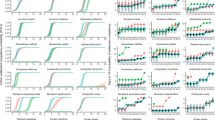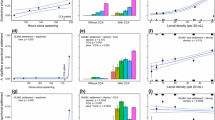Abstract
Acroporid corals are the main reef-building corals that provide three-dimensional habitats for other reef organisms, but are decreasing on many reefs worldwide due to natural and anthropogenic disturbances. In this study, temporal patterns of larval settlement and survivorship of two broadcast-spawning acroporid coral species, Acropora muricata and A. valida, were examined through laboratory rearing experiments to better understand the potential for larval dispersal of this important coral group. Many larvae were attached (but not metamorphosed) to settlement tiles on the first examination 3–4 days after spawning (AS). The first permanent larval settlement (i.e. metamorphosed and permanently settled juvenile polyps) occurred at 5–6 days AS, and most larval settlement (85–97% of total) occurred within 9–10 days AS. Larval survivorship decreased substantially to around 50% by the first week of the experiment and to approximately 10% by the second to third week. The rates of larval attachment, settlement, and the initial drop in survivorship of larvae suggest that effective dispersal of some acroporid species may largely be completed within the first few weeks AS.


Similar content being viewed by others
References
Andrews JC, Gay S, Sammarco PW (1989) Models of dispersal and recruitment of coral larvae around an isolated reef (Helix Reef) in the central Great Barrier Reef. Proc 6th Int Coral Reef Cong 2:469–474
Ayre DJ, Hughes TP (2000) Genotypic diversity and gene flow in brooding and spawning corals along the Great Barrier Reef, Australia. Evolution Int J Org Evolution 54:1590–1605
Ayre DJ, Hughes TP (2004) Climate change, genotypic diversity and gene flow in reef-building corals. Ecol Lett 7:273–278. doi:https://doi.org/10.1111/j.1461-0248.2004.00585.x
Baird A (1998) The length of the larval phase in corals: new insights into patterns of reef connectivity. Aust Coral Reef Soc Newsl 27:6–8
Bellwood DR, Hughes TP, Folke C, Nyström M (2004) Confronting the coral reef crisis. Nature 429:827–833. doi:https://doi.org/10.1038/nature02691
Black KP (1993) The relative importance of local retention and inter-reef dispersal of neutrally buoyant material on coral reefs. Coral Reefs 12:43–53. doi:https://doi.org/10.1007/BF00303783
Carlon DB, Olson RR (1993) Larval dispersal distance as an explanation for adult spatial pattern in two Caribbean reef corals. J Exp Mar Biol Ecol 173:247–263. doi:https://doi.org/10.1016/0022-0981(93)90056-T
Gardner TA, Côté IM, Gill JA, Grant A, Watkinson AR (2003) Long-term region-wide declines in Caribbean corals. Science 301:958–960. doi:https://doi.org/10.1126/science.1086050
Gay SL, Andrews JC (1994) The effect of recruitment strategies on coral larvae settlement distribution at Helix Reef. In: Sammarco PW, Heron ML (eds) The bio-physics of marine larval dispersal, Coastal and Estuarine Studies 45. American Geophysical Union, Washington, DC, pp 73–88
Harrison PL (1993) Coral spawning on the Great Barrier Reef. Search 24:45–48
Harrison PL (1997) Settlement competency periods and dispersal potential of planula larvae of the reef coral Acropora longicyathus. Australian Coral Reef Society Proceedings: 263
Harrison PL (2006) Settlement competency periods and dispersal potential of scleractinian reef coral larvae. In: Proceedings of the 10th Coral Reef Symposium, pp 78–82
Harrison PL, Booth DJ (2007) Coral reefs: naturally dynamic and increasingly disturbed ecosystems. In: Connell SD, Gillanders BM (eds) Marine Ecology. Oxford University Press, Melbourne, pp 316–377
Harrison PL, Wallace CC (1990) Reproduction, dispersal and recruitment of scleractinian corals. In: Dubinsky Z (ed) Coral Reef Ecosystems, Ecosystems of the World, Vol. 25 edn. Elsevier Science Publishers, Amsterdam, pp 133–207
Harii S, Kayanne H (2003) Larval dispersal, recruitment, and adult distribution of the brooding stony octocoral Heliopora coerulea on Ishigaki Island, southwest Japan. Coral Reefs 22:188–196. doi:https://doi.org/10.1007/s00338-003-0302-9
Harii S, Nadaoka K, Yamamoto M, Iwao K (2007) Temporal changes in settlement, lipid content and lipid composition of larvae of the spawning hermatypic coral Acropora tenuis. Mar Ecol Prog Ser 346:89–96. doi:https://doi.org/10.3354/meps07114
Harii S, Kayanne H, Takigawa H, Hayashibara T, Yamamoto M (2002) Larval survivorship, competency periods and settlement of two brooding corals, Heliopora coerulea and Pocillopora damicornis. Mar Biol (Berl) 141:39–46. doi:https://doi.org/10.1007/s00227-002-0812-y
Hoegh-Guldberg O (1999) Climate change, coral bleaching and the future of the world’s coral reefs. Mar Freshw Res 50:839–866. doi:https://doi.org/10.1071/MF99078
Hughes TP, Baird AH, Dinsdale EA, Moltschaniwskyj NA, Pratchett MS, Tanner JE et al (2000) Supply-side ecology works both ways: the link between benthic adults, fecundity, and larval recruits. Ecology 81:2241–2249
Hughes TP, Baird AH, Dinsdale EA, Harriott VJ, Moltschaniwskyj NA, Pratchett MS et al (2002) Detecting regional variation using meta-analysis and large-scale sampling: latitudinal patterns in recruitment. Ecology 83:436–451
Machin D, Cheung YB, Parmar MKB (2006) Survival analysis, a practical approach, 2nd edn. Wiley, West Sussex
Miller K, Mundy C (2003) Rapid settlement in broadcast spawning corals: implications for larval dispersal. Coral Reefs 22:99–106. doi:https://doi.org/10.1007/s00338-003-0290-9
Mundy CN, Babcock RC (1998) Role of light intensity and spectral quality in coral settlement: Implications for depth-dependent settlement? J Exp Mar Biol Ecol 223:235–255. doi:https://doi.org/10.1016/S0022-0981(97)00167-6
Nishikawa A, Katoh M, Sakai K (2003) Larval settlement rates and gene flow of broadcast-spawning (Acropora tenuis) and planula-brooding (Stylophora pistillata) corals. Mar Ecol Prog Ser 256:87–97. doi:https://doi.org/10.3354/meps256087
Nozawa Y, Harrison PL (2002) Larval settlement patterns, dispersal potential, and the effect of temperature on settlement of larvae of the reef coral, Platygyra daedalea, from the Great Barrier Reef. Proc 9th Int Coral Reef Symp 1:409–415
Nozawa Y, Harrison PL (2005) Temporal settlement patterns of larvae of the broadcast spawning reef coral Favites chinensis and the broadcast spawning and brooding reef coral Goniastrea aspera from Okinawa, Japan. Coral Reefs 24:274–282. doi:https://doi.org/10.1007/s00338-005-0476-4
Nozawa Y, Tokeshi M, Nojima S (2006) Reproduction and recruitment of scleractinian corals in a high-latitude coral community, Amakusa, southwestern Japan. Mar Biol (Berl) 149:1047–1058. doi:https://doi.org/10.1007/s00227-006-0285-5
Nozawa Y, Harrison PL (2007) Effects of elevated temperature on larval settlement and post-settlement survival in scleractinian corals, Acropora solitaryensis and Favites chinensis. Mar Biol (Berl) 152:1181–1185. doi:https://doi.org/10.1007/s00227-007-0765-2
Oliver JK, Willis BL (1987) Coral spawn slicks in the Great Barrier Reef: preliminary observations. Mar Biol (Berl) 94:521–529. doi:https://doi.org/10.1007/BF00431398
Richmond RH (1987) Energetics, competency, and long-distance dispersal of planula larvae of the coral Pocillopora damicornis. Mar Biol (Berl) 93:527–533. doi:https://doi.org/10.1007/BF00392790
Richmond RH (1989) Competency and dispersal of spawned versus brooded coral planulae larvae. Proc 6th Int Coral Reef Symp 2:827–831
Roberts CM (1997) Connectivity and management of Caribbean coral reefs. Science 278:1454–1457. doi:https://doi.org/10.1126/science.278.5342.1454
Veron JEN (1995) Corals in space and time: the biogeography and evolution of the scleractinia. UNSW Press, Sydney
Wallace CC (1999) Staghorn corals of the World: a revision of the coral genus Acropora. CSIRO, Collingwood
Williams DM, Wolanski E, Andrews JC (1984) Transport mechanisms and the potential movement of planktonic larvae in the central region of the Great Barrier Reef. Coral Reefs 3:229–236. doi:https://doi.org/10.1007/BF00288259
Willis BL, Oliver JK (1990) Direct tracking of coral larvae: implication for dispersal studies of plankton complex environments. Ophelia 32:145–162
Wilson JR, Harrison PL (1998) Settlement-competency periods of larvae of three species of scleractinian corals. Mar Biol (Berl) 131:339–345. doi:https://doi.org/10.1007/s002270050327
Wolanski E, Jupp DLP, Pickard GL (1986) Currents and coral reefs. Oceanus 29:83–89
Acknowledgments
This study was supported in part by an Australian Research Council Large Grant to P·H. and a Southern Cross University postgraduate student grant to Y. N. We thank the staff of HIRS and SCU for their hospitality and support. We also thank Dr S. Ward for her help and Prof M. Tokeshi and Dr James D. Reimer for comments on the manuscript. The experiments performed here complied with the current laws of Australia.
Author information
Authors and Affiliations
Corresponding author
Additional information
Communicated by S.D. Connell.
Rights and permissions
About this article
Cite this article
Nozawa, Y., Harrison, P.L. Temporal patterns of larval settlement and survivorship of two broadcast-spawning acroporid corals. Mar Biol 155, 347–351 (2008). https://doi.org/10.1007/s00227-008-1034-8
Received:
Accepted:
Published:
Issue Date:
DOI: https://doi.org/10.1007/s00227-008-1034-8




